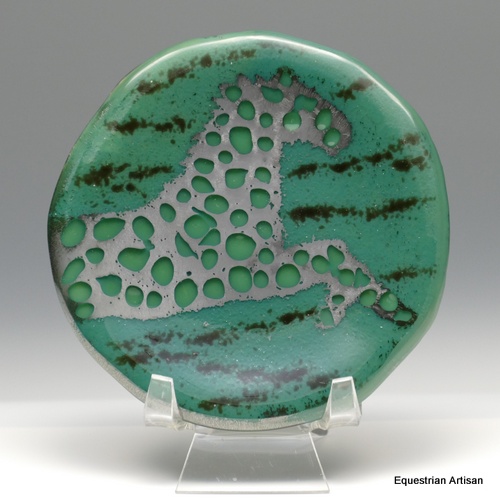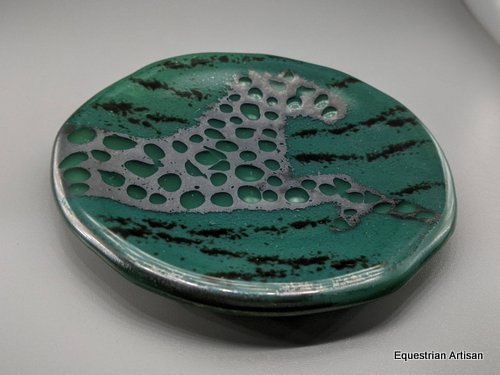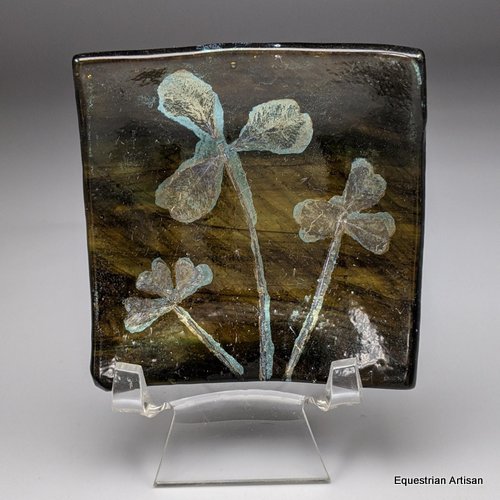Illuminated Grey Horse On Steel Green Art Glass 4″
$49.00
This bowl is part of our More Horses Collection of equestrian home decor. It is 4″ in diameter. The green glass used in this piece has a very unusual property: when heated, it turns from green to matte grey unless it is covered with clear glass, hence its name “steel green”.
I hope you enjoy this one-of-a-kind art glass piece. It can simply be admired on the plate stand that comes with it, or you can give it a job to do. Use it to hold jewelry, change, or keys. Place a small candle or decorative soap in it. Use it to serve dips and small food items. Whatever you decide, It is a beautiful complement to the home of any horse lover, either yourself or someone you know who appreciates fine things.
Creating the dish was a 5-step process.
Selecting the Glass: First two circles of glass were cut to the dimensions of the finished piece, one clear and the other steel green.
Creating the Design: The horse pattern was created using a process called “powder printing”. Finely ground clear glass (known as powder frit) was sifted onto the green glass circle, everywhere but on the horse itself, using a stencil created on my laser cutter. After lifting the stencil and removing stray glass powder pieces of larger frit (the size of gravel) were positioned on the horse’s body. As a final touch, dark green powder frit was carefully sifted to create a wavy background. This top layer was placed over the clear glass circle and it went into a kiln.
Fusing in the Kiln: The two layers were heated to 1475 degrees, the temperature at which glass melts and the layers fused together. The powdered glass coating protected the background so it stayed shiny and green while the horse changed to a matte grey color. The larger frit, in addition to protecting the green, diluted the underlying color as they melted causing it to become semi-transparent.
Refining the Edges: After cooling, the edge of the piece was ground to eliminate irregularities and it was…
5)…fired one more time to 1425 degrees to melt the edge and “fire polish” the rim.
Shaping the Dish: Lastly, the piece was put back in the kiln, this time on top of a mold, and heated to 1250 degrees. At this temperature the glass softened and gravity caused it to sink into the mold and assume its final shape.
Description
This bowl is part of our More Horses Collection of equestrian home decor. It is 4″ in diameter. The green glass used in this piece has a very unusual property: when heated, it turns from green to matte grey unless it is covered with clear glass, hence its name “steel green”.
I hope you enjoy this one-of-a-kind art glass piece. It can simply be admired on the plate stand that comes with it, or you can give it a job to do. Use it to hold jewelry, change, or keys. Place a small candle or decorative soap in it. Use it to serve dips and small food items. Whatever you decide, It is a beautiful complement to the home of any horse lover, either yourself or someone you know who appreciates fine things.
Creating the dish was a 5-step process.
Selecting the Glass: First two circles of glass were cut to the dimensions of the finished piece, one clear and the other steel green.
Creating the Design: The horse pattern was created using a process called “powder printing”. Finely ground clear glass (known as powder frit) was sifted onto the green glass circle, everywhere but on the horse itself, using a stencil created on my laser cutter. After lifting the stencil and removing stray glass powder pieces of larger frit (the size of gravel) were positioned on the horse’s body. As a final touch, dark green powder frit was carefully sifted to create a wavy background. This top layer was placed over the clear glass circle and it went into a kiln.
Fusing in the Kiln: The two layers were heated to 1475 degrees, the temperature at which glass melts and the layers fused together. The powdered glass coating protected the background so it stayed shiny and green while the horse changed to a matte grey color. The larger frit, in addition to protecting the green, diluted the underlying color as they melted causing it to become semi-transparent.
Refining the Edges: After cooling, the edge of the piece was ground to eliminate irregularities and it was…
5)…fired one more time to 1425 degrees to melt the edge and “fire polish” the rim.
Shaping the Dish: Lastly, the piece was put back in the kiln, this time on top of a mold, and heated to 1250 degrees. At this temperature the glass softened and gravity caused it to sink into the mold and assume its final shape.
Additional information
| Weight | .9 lbs |
|---|---|
| Dimensions | 8 × 8 × 4 in |















